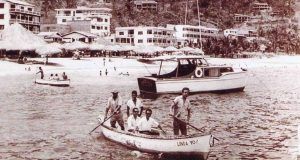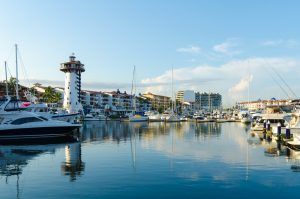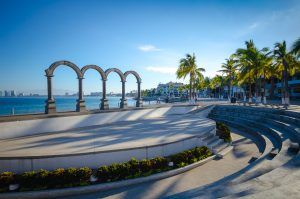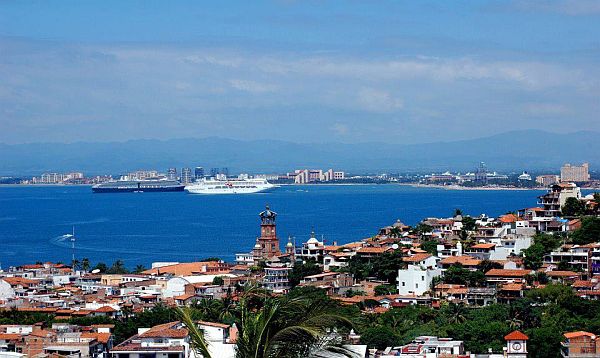Puerto Vallarta is having a big birthday party this week as it celebrates its centennial as a municipality and 50 years as a city. The party started earlier this year with a series of artistic, cultural and sports activities.
On May 31, 1918, local government officials in Las Peñas, Mexico gathered just north of the Cuale River on the Bay of Banderas to officially commemorate the granting of municipality status to the town and introduce its new name: Puerto Vallarta.
 |
Named for Don Ignacio L. Vallarta, a former governor of the state of Jalisco, Puerto Vallarta remained a small fishing village until local banana plantations and other fruit and vegetable growers began exporting to other countries in the 1920s. By the 1930s, tourists from other parts of Mexico and other countries began discovering the tropical beauty of Puerto Vallarta and its dramatic setting.
The city's natural beauty is well known and its people carry a reputation for warmth and friendliness, confirmed by at least one major travel magazine.
More tourists began trickling in to Puerto Vallarta in the 1950s after Mexicana Airlines inaugurated its Guadalajara to Puerto Vallarta route, which provided an alternative to then-glamorous Acapulco further south on Mexico's Pacific coast.
One of the first expat arrivals in the fifties was Jack Cawood. Born just outside of Lincoln, Nebraska in 1927, he was living in California with his Peruvian wife and kids when he read something about a fishing village on the west coast of Mexico that captured his interest.
"I had always wanted to live in a small fishing village more than any other place in the world," Cawood said. "We flew to Guadalajara and then took a small plane to Puerto Vallarta. There were few roads and few cars at that time so I got a horse."
The town had grown to several thousand people by the 1950s and began attracting an early colony of Mexican and American artists and writers drawn to its tranquil beauty and vistas of Banderas Bay.
Cawood said there were no hotels when he moved his family to Puerto Vallarta, so he got into the construction business. He built a seven-room hotel, which became the Playa del Oro, and then a fifteen-room condominium.
"The Americans were the first to come and fish," he said. "Fishing was great so I bought a boat, one of many to come. We had lobster, shrimp, oysters, red snapper and a wide variety of other fish. The bay was good to us then."
His kids played in the Pitillal River, which flowed into the bay in what is now known as the Hotel Zone, north of El Centro.
 |
But perhaps the signature event that catapulted Puerto Vallarta on to the international travel stage was the making of John Huston's The Night of the Iguana in 1963. Fueled by the delicious gossip created by the Richard Burton and Elizabeth Taylor affair, paparazzi from seemingly everywhere descended on Puerto Vallarta and gave it worldwide recognition.
"Everyone hung out at the Oceano Hotel's bar back then," Cawood said. "Liz and Dick were cordial to everyone. They lived in a couple of villas on the hill above the Cuale River, which was known as Gringo Gulch because of all the expats living up there.
"The film's notoriety was a key inflection point for Puerto Vallarta's tourism growth. The state of Jalisco began pouring money into infrastructure projects like new roads and bridges and the Gustavo Diaz Ordaz Airport, which was built to accommodate direct flights from international cities.
By 1970, Mexico's president approved Puerto Vallarta for tourist development funds to help meet the demands of its new tourism growth. Soon, direct flights from Paris and other major world capitals began depositing sun-starved tourists on the city's beaches.
New hotels began sprouting in the early 1970s, including Puerto Vallarta's first luxury hotel, The Camino Real. It sits on one of the south shore's best beaches, about two miles south of town. The Sheraton Buganvilias and other brand name hotels soon followed.
 |
Long-time Puerto Vallarta expat Jeri Grant arrived on a private yacht in 1980 and was struck by the city's beauty.
"It was beautiful and green and the air was so fresh," Grant said. "When I first saw it from the yacht, the whole town was a maze of white with red-tile roofs. It seemed magical."
Grant, now 63 and selling real estate, spent a few years in the 1980s delivering yachts to owners in Mexico before finally settling in Puerto Vallarta and buying a two-bedroom home in Colonia Aramara, just a bit east of today's cruise ship terminal.
"Back then I think we had just one stop light and stop signs were treated as just a suggestion," she said. "I really liked the way it felt living in Puerto Vallarta. Everybody was friendly and said hello and good morning. It was just an easy place to live and everyone was happy."
By the 1990s, visitors were arriving in record numbers by plane, ship, car and bus to enjoy the charms of cobblestoned streets, golden swaths of sandy beach, a restaurant scene second only to Mexico City, a never-ending list of outdoor adventures and, of course, people who made you feel welcome.
So far this century, Puerto Vallarta has swelled to well over 300,000 full-time residents, including one of the largest expat communities in Mexico. It continues to rank in the top three tourist destinations in the country.
But with growth comes more development and the pain of progress. Several decades of unrestrained building along the bay has created big city traffic problems, high-rise condominium construction and often crowding in El Centro and La Zona Romantica during "high season."
 |
At 100, the old girl has applied a new coat of lipstick and still looks beautiful. She continues to delight tourists and expats alike, especially Baby Boomers who are looking for retirement and younger generations searching for adventure.
Jack Cawood left Puerto Vallarta to live in the U.S. a while before moving to Europe for a number of years. But the pull of the place is strong once you have tasted her. At 92, Jack is back, living out his life in the Marina and sailing his boat every day.
Jeri Grant never left Puerto Vallarta and never will.
"It's hard to explain because it's one of those things where the town just bites you and you're done," she said. "I feel very blessed to have spent half of my life here."
Happy birthday, old girl. Your millions of adoring fans love you.
Robert Nelson is the founder and co-owner of Expats In Mexico with his wife Felice. Bob blogs, edits and writes content that covers a wide variety of topics of interest to expats living in Mexico and aspiring expats who are planning a move to the country. For more information, visit ExpatsInMexico.com, or follow ExpatsInMex on Facebook.


